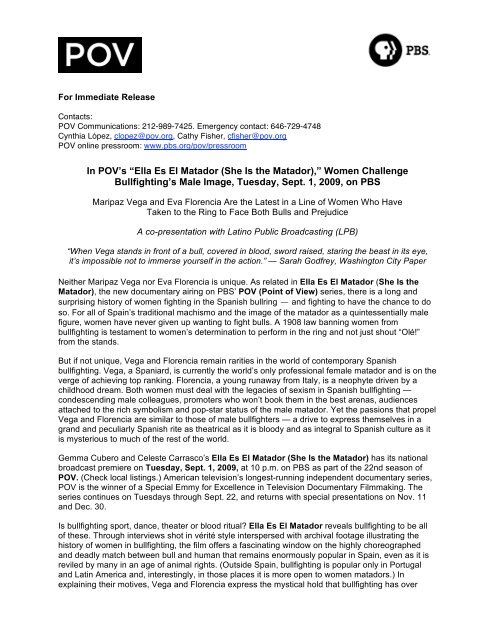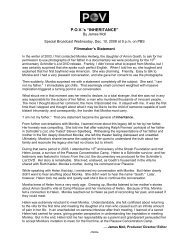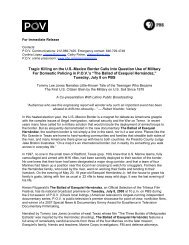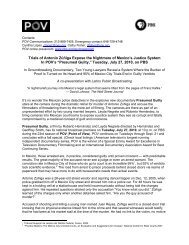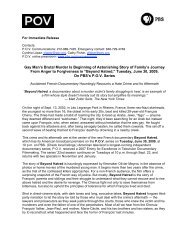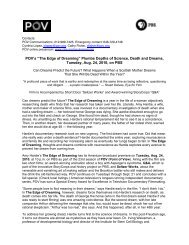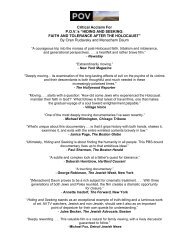Ella Es El Matador (She Is the Matador) - American Documentary, Inc.
Ella Es El Matador (She Is the Matador) - American Documentary, Inc.
Ella Es El Matador (She Is the Matador) - American Documentary, Inc.
You also want an ePaper? Increase the reach of your titles
YUMPU automatically turns print PDFs into web optimized ePapers that Google loves.
For Immediate ReleaseContacts:POV Communications: 212-989-7425. Emergency contact: 646-729-4748Cynthia López, clopez@pov.org, Cathy Fisher, cfisher@pov.orgPOV online pressroom: www.pbs.org/pov/pressroomIn POV’s “<strong><strong>El</strong>la</strong> <strong>Es</strong> <strong>El</strong> <strong>Matador</strong> (<strong>She</strong> <strong>Is</strong> <strong>the</strong> <strong>Matador</strong>),” Women ChallengeBullfighting’s Male Image, Tuesday, Sept. 1, 2009, on PBSMaripaz Vega and Eva Florencia Are <strong>the</strong> Latest in a Line of Women Who HaveTaken to <strong>the</strong> Ring to Face Both Bulls and PrejudiceA co-presentation with Latino Public Broadcasting (LPB)“When Vega stands in front of a bull, covered in blood, sword raised, staring <strong>the</strong> beast in its eye,it’s impossible not to immerse yourself in <strong>the</strong> action.” — Sarah Godfrey, Washington City PaperNei<strong>the</strong>r Maripaz Vega nor Eva Florencia is unique. As related in <strong><strong>El</strong>la</strong> <strong>Es</strong> <strong>El</strong> <strong>Matador</strong> (<strong>She</strong> <strong>Is</strong> <strong>the</strong><strong>Matador</strong>), <strong>the</strong> new documentary airing on PBS’ POV (Point of View) series, <strong>the</strong>re is a long andsurprising history of women fighting in <strong>the</strong> Spanish bullring — and fighting to have <strong>the</strong> chance to doso. For all of Spain’s traditional machismo and <strong>the</strong> image of <strong>the</strong> matador as a quintessentially malefigure, women have never given up wanting to fight bulls. A 1908 law banning women frombullfighting is testament to women’s determination to perform in <strong>the</strong> ring and not just shout “Olé!”from <strong>the</strong> stands.But if not unique, Vega and Florencia remain rarities in <strong>the</strong> world of contemporary Spanishbullfighting. Vega, a Spaniard, is currently <strong>the</strong> world’s only professional female matador and is on <strong>the</strong>verge of achieving top ranking. Florencia, a young runaway from Italy, is a neophyte driven by achildhood dream. Both women must deal with <strong>the</strong> legacies of sexism in Spanish bullfighting —condescending male colleagues, promoters who won’t book <strong>the</strong>m in <strong>the</strong> best arenas, audiencesattached to <strong>the</strong> rich symbolism and pop-star status of <strong>the</strong> male matador. Yet <strong>the</strong> passions that propelVega and Florencia are similar to those of male bullfighters — a drive to express <strong>the</strong>mselves in agrand and peculiarly Spanish rite as <strong>the</strong>atrical as it is bloody and as integral to Spanish culture as itis mysterious to much of <strong>the</strong> rest of <strong>the</strong> world.Gemma Cubero and Celeste Carrasco’s <strong><strong>El</strong>la</strong> <strong>Es</strong> <strong>El</strong> <strong>Matador</strong> (<strong>She</strong> <strong>Is</strong> <strong>the</strong> <strong>Matador</strong>) has its nationalbroadcast premiere on Tuesday, Sept. 1, 2009, at 10 p.m. on PBS as part of <strong>the</strong> 22nd season ofPOV. (Check local listings.) <strong>American</strong> television’s longest-running independent documentary series,POV is <strong>the</strong> winner of a Special Emmy for Excellence in Television <strong>Documentary</strong> Filmmaking. Theseries continues on Tuesdays through Sept. 22, and returns with special presentations on Nov. 11and Dec. 30.<strong>Is</strong> bullfighting sport, dance, <strong>the</strong>ater or blood ritual? <strong><strong>El</strong>la</strong> <strong>Es</strong> <strong>El</strong> <strong>Matador</strong> reveals bullfighting to be allof <strong>the</strong>se. Through interviews shot in vérité style interspersed with archival footage illustrating <strong>the</strong>history of women in bullfighting, <strong>the</strong> film offers a fascinating window on <strong>the</strong> highly choreographedand deadly match between bull and human that remains enormously popular in Spain, even as it isreviled by many in an age of animal rights. (Outside Spain, bullfighting is popular only in Portugaland Latin America and, interestingly, in those places it is more open to women matadors.) Inexplaining <strong>the</strong>ir motives, Vega and Florencia express <strong>the</strong> mystical hold that bullfighting has over
Spaniards, what Florencia calls “something beyond <strong>the</strong> cruelty . . . a connection between man andbeast.”Vega also speaks of a magical connection to <strong>the</strong> bull — and to death. “Without <strong>the</strong> bull <strong>the</strong>re isnothing. . . . We all believe <strong>the</strong> bull is born to die in <strong>the</strong> ring. Keep in mind that you’re giving him achance to fight for his life. It’s a fight between you and <strong>the</strong> bull. Ei<strong>the</strong>r one can win <strong>the</strong> battle.” In fact,while <strong>the</strong> odds are stacked against <strong>the</strong> bull, <strong>the</strong> matador faces real danger. In <strong>the</strong> course of <strong>the</strong>filming of <strong><strong>El</strong>la</strong> <strong>Es</strong> <strong>El</strong> <strong>Matador</strong>, Vega is gored in <strong>the</strong> thigh — and it isn’t her first injury. <strong>She</strong> shows <strong>the</strong>stoic courage required of matadors at such moments. Later, she refers ruefully to a bullfightingtradition that says that with each goring, a little of <strong>the</strong> matador’s courage seeps out.Vega is <strong>the</strong> daughter of a once-aspiring bullfighter, and each of her five bro<strong>the</strong>rs trained to bematadors. It was her bro<strong>the</strong>rs’ example that inspired her, at nine years old, to face her “first calf.”Yet like <strong>the</strong>ir fa<strong>the</strong>r before <strong>the</strong>m, her bro<strong>the</strong>rs failed to rise higher than apprentice bullfighters, whileVega has succeeded in becoming a matador and is poised to join <strong>the</strong> ring’s top ranks. “To be able todominate <strong>the</strong> bull and create something beautiful and to see <strong>the</strong> people embrace your performance,that’s why I love being a matador,” she says.For <strong>the</strong> young Florencia — and for her disconcerted family — bullfighting arrived like a bolt out of <strong>the</strong>blue, or “an arrow to <strong>the</strong> heart,” as she puts it. It struck <strong>the</strong> moment when, as a little girl fromTuscany who knew nothing of Spain, much less bullfighting, beyond what she saw in books andmagazines, she was transfixed by “a picture of a bullfighter executing a beautiful pass.” <strong>She</strong> decided<strong>the</strong>n and <strong>the</strong>re to become a matador, a childish ambition her family naturally tried to dismiss.When, at 16, Florencia asked her family to send her to Spain, <strong>the</strong>y just as naturally refused. So sheran off to Seville to pursue <strong>the</strong> difficult life of an apprentice bullfighter. (It takes 25 sanctionedmatches to qualify as a matador.) When her family finally accepted that Florencia’s passion was nowhim, but “something that had profoundly entered my soul,” as she says, <strong>the</strong>y began attendingbullfights and learning about <strong>the</strong>ir daughter’s obsession. The recollections and musings ofFlorencia’s fa<strong>the</strong>r, Domenico, reveal <strong>the</strong> struggles of an outsider to grasp <strong>the</strong> allure of bullfighting.In <strong>the</strong> period documented by <strong><strong>El</strong>la</strong> <strong>Es</strong> <strong>El</strong> <strong>Matador</strong>, <strong>the</strong> greatest threat to <strong>the</strong> women, or at least to<strong>the</strong>ir dreams, turns out to be not <strong>the</strong> bulls and <strong>the</strong>ir horns, but <strong>the</strong> patriarchal regime that guardsbullfighting’s masculine image. Vega’s real challenge, despite all her success, is getting <strong>the</strong> chancefight in <strong>the</strong> prestigious arenas that would vault her to prominence; Florencia’s challenge is simplygetting <strong>the</strong> 25 official matches she needs to realize her dream.“Bullfighting is <strong>the</strong> quintessential symbol of masculinity and bravery in Spanish culture,” sayfilmmakers Cubero and Carrasco, both born and raised in Spain. “Making this documentary aboutfemale matadors means changing this symbol and shifting <strong>the</strong> gender roles that have been definedfor centuries. We want to open a window for viewers to enter into a unique world without judgment,while exploring <strong>the</strong> universal struggle of our two protagonists.”<strong><strong>El</strong>la</strong> <strong>Es</strong> <strong>El</strong> <strong>Matador</strong> (<strong>She</strong> <strong>Is</strong> <strong>the</strong> <strong>Matador</strong>) is a production of Talcual Films. www.talcualfilms.comand is distributed in North America by Women Make Movies (WMM), www.wmm.com.About <strong>the</strong> Filmmakers:Gemma Cubero, Director, Producer, Executive Producer, Writer<strong><strong>El</strong>la</strong> <strong>Es</strong> <strong>El</strong> <strong>Matador</strong> marks Spanish filmmaker Gemma Cubero’s directorial debut. Previously sheworked as associate producer and researcher on Lourdes Portillo’s award-winning POVdocumentary Señorita Extraviada, about <strong>the</strong> killing of women in Juarez. Cubero also produced,with Julio Medem, <strong>the</strong> feature-length documentaries “What’s Under Your Hat?” and “One Percent:Schizophrenia.” In 2006 she founded Talcual Films, an independent production company based in<strong>the</strong> United States and Spain. Now living in San Francisco, Cubero received a bachelor’s degree,cum laude, in journalism from <strong>El</strong>on University in <strong>El</strong>on, N.C.
Celeste Carrasco, Director, Producer, Cinematographer, Editor, WriterCeleste Carrasco is a native of Barcelona, Spain. Her film credits include first assistant director onMarta Balletbò-Coll’s “Honey, I’ve Sent <strong>the</strong> Men to <strong>the</strong> Moon,” production manager on LourdesPortillo’s Señorita Extraviada and producer on Lisset Barcellos’ “Both.” Previously, she receivedsponsorship from <strong>the</strong> Smithsonian Institution to conduct research at <strong>the</strong> Film and Media Departmentof <strong>the</strong> Exploratorium in San Francisco. Carrasco currently works in <strong>the</strong> technical department of <strong>the</strong>Madrid Opera House, combining her film work with <strong>the</strong>ater.Credits:Co-directors/Producers:Executive Producers:Cinematographer:Editors:Music:Gemma Cubero, Celeste Carrasco<strong>She</strong>ila C. Johnson, Suzanne LaFetra, Gemma CuberoCeleste CarrascoCarla Gutiérrez, Vivien Hillgrove, Jennifer Chinlund, Celeste CarrascoMichael Galasso, Todd Boekelheide, MartirioRunning Time: 56:46Awards & Festivals:• Tribeca All Access Creative Promise Award for <strong>Documentary</strong>, 2008• Independent Film Week Spotlight on Documentaries, 2008• World premiere, 24th Guadalajara International Film Festival, 2009• U.S. premiere, SILVERDOCS AFI/Discovery Channel <strong>Documentary</strong> Festival, 2009Created in 1998 by Edward James Olmos and Marlene Dermer, Latino PublicBroadcasting (LPB) is a nonprofit organization funded by <strong>the</strong> Corporation for PublicBroadcasting. LPB’s mission is to support <strong>the</strong> development, production, post-production,acquisition and distribution of non-commercial educational and cultural television that isrepresentative of or addresses issues of particular interest to U.S. Latinos. Theseprograms are produced for dissemination to public broadcasting stations and o<strong>the</strong>r publictelecommunications entities. Mr. Olmos is presently LPB’s Chairman of <strong>the</strong> Board of Directors. For moreinformation please visit www.lpbp.org.Produced by <strong>American</strong> <strong>Documentary</strong>, <strong>Inc</strong>. and beginning its 22nd season on PBS in2009, <strong>the</strong> award-winning POV series is <strong>the</strong> longest-running showcase on <strong>American</strong>television to feature <strong>the</strong> work of today’s best independent documentary filmmakers.Airing June through September, with primetime specials during <strong>the</strong> year, POV has brought more than 275acclaimed films to millions nationwide and has a Webby Award-winning online series, POV's Borders.Since 1988, POV has pioneered <strong>the</strong> art of presentation and outreach using independent nonfiction mediato build new communities in conversation about today's most pressing social issues. More information isavailable at www.pbs.org/pov.POV Interactive (www.pbs.org/pov)POV’s award-winning Web department produces special features for every POV presentation, extending<strong>the</strong> life of our films through filmmaker interviews, story updates, podcasts, streaming video andcommunity-based and educational content that involves viewers in activities and feedback. POVInteractive also produces our Web-only showcase for interactive storytelling, POV’s Borders. In addition,<strong>the</strong> POV Blog is a ga<strong>the</strong>ring place for documentary fans and filmmakers to discuss and debate <strong>the</strong>irfavorite films, get <strong>the</strong> latest news and link to fur<strong>the</strong>r resources. The POV website, blog and film archivesform a unique and extensive online resource for documentary storytelling.POV Community Engagement and EducationPOV works with local PBS stations, educators and community organizations to present free screeningsand discussion events to inspire and engage communities in vital conversations about our world. As aleading provider of quality nonfiction programming for use in public life, POV offers an extensive menu ofresources, including free discussion guides and curriculum-based lesson plans. In addition, POV’s Youth
Views works with youth organizers and students to provide <strong>the</strong>m with resources and training so <strong>the</strong>y mayuse independent documentaries as a catalyst for social change.Major funding for POV is provided by PBS, The John D. and Ca<strong>the</strong>rine T. MacArthur Foundation, NationalEndowment for <strong>the</strong> Arts, The Educational Foundation of America, JPMorgan Chase Foundation, NewYork City Department of Cultural Affairs, New York State Council on <strong>the</strong> Arts, Lower Manhattan CulturalCouncil, The September 11th Fund and public television viewers. Funding for POV's Diverse VoicesProject is provided by <strong>the</strong> Corporation for Public Broadcasting and The Andy Warhol Foundation for <strong>the</strong>Visual Arts. Special support provided by <strong>the</strong> Academy of Motion Picture Arts and Sciences. POV ispresented by a consortium of public television stations, including KCET Los Angeles, WGBH Boston andTHIRTEEN in association with WNET.ORG.<strong>American</strong> <strong>Documentary</strong>, <strong>Inc</strong>. (www.amdoc.org)<strong>American</strong> <strong>Documentary</strong>, <strong>Inc</strong>. (AmDoc) is a multimedia company dedicated to creating, identifying andpresenting contemporary stories that express opinions and perspectives rarely featured in mainstreammedia outlets. AmDoc is a catalyst for public culture, developing collaborative strategic engagementactivities around socially relevant content on television, online and in community settings. These activitiesare designed to trigger action, from dialogue and feedback to educational opportunities and communityparticipation. Simon Kilmurry is executive director of <strong>American</strong> <strong>Documentary</strong> | POV.DVD REQUESTS: Please note that a broadcast version of this film is available upon request, as<strong>the</strong> film may be edited to comply with new FCC regulations.Media Sponsor:


